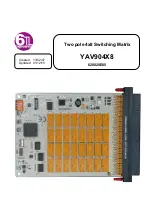
Chapter 4
– Functions
GE Reason Switches
94
REASON SWITCHES-TM-EN-3
value, and then there will be effectively traffic prioritization defined by traffic
type, not by VLAN. It is possible to prioritize traffic based on Ethertype, UDP or
TCP transport protocol, and so on.
10.3
Differentiated Service Code Point (DSCP)
The use of specific field at the IP headers was standardized at RFC 2474 document. It
specifies the usage of a 6-bit length field, the Differentiated Service Code Point (DSCP)
bits that are used to set which priority the network should use for this incoming IP
frame. Note that, while CoS bits are mapped in data-link layer, DSCP is used at
network layer, thus at IP communication environment. Such environment includes
NTP and PTP protocols (if mapped to UDP transport) but they are not allowed to
GOOSE or Sampled Values data. Figure below shows the IP header and DSCP bits
Figure 55: IP Header frame and Differentiated Service Code Point explained
The Type-of-Service (ToS) byte is exploded, as Differentiated Service Code Point
(DSCP) bits are inside this field. DSCP is a 6-bit length field that allows the IP header to
carry prioritized information of the incoming data, just as the CoS bits do in an
802.1Q frame. In addition, there are two remaining bits, the Explicit Congestion
Notification (ECN) bits, defined in the RFC 3168 document.
Those last fields (ECN bits) allow the IP packets to carry information if the packet has
suffered congestion at data traffic. Thus, as there is marking at the packet that it
suffered from congestion at the path between sender and receiver, the sender can
adjust its bandwidth to the network before there is data lose. This mechanism makes
QoS more reliable, as there will be notification of congestion at the packet, and then
the hosts can adjust themselves to prevent losing data. Before this mechanism, the
only way to verify if the network was congested was losing packets.
IEC 61850-90-4 Technical Report gives some orientation in how bits should be used
in power system communication, as shown in the next three figures.
Figure 56: Mapping of applications for service levels, shown in section D.2.7 of the IEC
61850-90-4 Technical Report
Содержание T1000
Страница 2: ......
Страница 11: ...Figure 97 T1000 dimensions 298 Figure 98 S2020 and S2024G dimensions 299...
Страница 12: ......
Страница 41: ...Chapter 3 Hardware Design GE Reason Switches REASON SWITCHES TM EN 3 41 Figure 4 S2024G Switch...
Страница 103: ...GE Reason Switches Chapter 4 Functions REASON SWITCHES TM EN 3 103 Figure 64 Data Monitor Flow Network...
Страница 256: ......
Страница 274: ......
















































